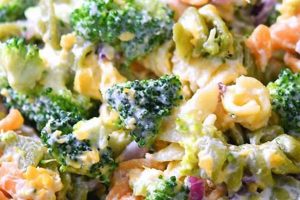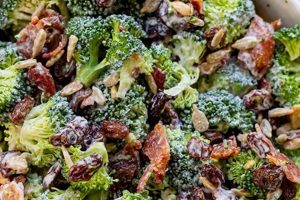Combinations of raw or cooked broccoli and cauliflower florets form the base of numerous salads, offering a versatile canvas for diverse flavors and textures. These salads can incorporate a wide range of ingredients, from dried fruits and nuts to cheeses and various dressings, creating dishes suitable as light lunches, side dishes, or potluck contributions. A simple example involves blanched florets tossed with dried cranberries, sunflower seeds, and a lemon vinaigrette.
Such culinary creations provide significant nutritional value, capitalizing on the vitamin and mineral richness of these cruciferous vegetables. They offer a good source of fiber, promoting digestive health, and contribute antioxidants, linked to various health benefits. Historically, while individual vegetable salads have long been consumed, the specific combination of broccoli and cauliflower in salads has gained popularity more recently, reflecting increasing awareness of their nutritional value and culinary versatility.
Further exploration will cover variations in preparation methods, dressing options, ingredient pairings, and tips for achieving optimal texture and flavor. Considerations for dietary restrictions and adaptations for seasonal ingredients will also be addressed.
Tips for Crafting Exceptional Broccoli and Cauliflower Salads
Achieving optimal flavor and texture requires attention to several key details. The following tips provide guidance for creating salads that highlight the versatility of these cruciferous vegetables.
Tip 1: Blanching for Optimal Texture: Briefly submerging florets in boiling water, followed by an immediate ice bath, preserves vibrant color and creates a tender-crisp texture, preventing mushiness. This technique enhances the overall salad experience.
Tip 2: Dressing Selection: Creamy dressings, such as those based on mayonnaise or yogurt, complement the mild flavor of the vegetables. Vinaigrettes offer a lighter option and can be customized with herbs, spices, and citrus.
Tip 3: Flavorful Additions: Incorporating contrasting elements elevates the salad. Consider dried fruits for sweetness, toasted nuts for crunch, or cheeses for savory depth. Roasted chickpeas or crumbled bacon can add protein and textural complexity.
Tip 4: Seasonality and Freshness: While available year-round, these vegetables peak in flavor during cooler months. Selecting fresh, firm heads ensures optimal quality. Consider seasonal ingredients for complementary flavors and visual appeal.
Tip 5: Balancing Flavors: Achieve harmony by balancing textures and flavors. If using a rich dressing, incorporate lighter elements like fresh herbs or a squeeze of lemon. If using strong-flavored additions, ensure they complement the vegetables without overpowering them.
Tip 6: Proper Storage: Store prepared salads in airtight containers in the refrigerator for up to three days. To maintain optimal freshness, add the dressing just before serving.
Tip 7: Creative Variations: Explore variations by incorporating other vegetables, grains, or legumes. Consider adding roasted sweet potatoes, quinoa, or black beans for added nutritional value and textural variety.
By employing these tips, one can create salads that not only showcase the nutritional benefits of these vegetables but also deliver delightful culinary experiences.
With these foundational elements established, the following section will delve into specific recipe examples and explore variations to cater to diverse palates and dietary preferences.
1. Fresh Ingredients
The foundation of any successful broccoli and cauliflower salad rests upon the quality and freshness of its primary components. Ingredient selection significantly impacts the overall flavor, texture, and nutritional value of the final dish. Utilizing fresh produce ensures optimal taste and maximizes health benefits.
- Sourcing Produce
Selecting produce at its peak freshness is paramount. Locally sourced, seasonal broccoli and cauliflower often offer superior flavor and nutritional content. Farmers’ markets provide access to recently harvested vegetables, minimizing time between farm and table. Careful inspection for firm heads, vibrant color, and absence of blemishes ensures optimal quality. Proper storage techniques, such as refrigeration in breathable packaging, maintain freshness until preparation.
- Complementary Ingredients
Freshness extends beyond the core vegetables. Incorporating other fresh ingredients enhances the overall salad experience. Fresh herbs, such as parsley, dill, or mint, provide bright, aromatic notes. Other vegetables, like crisp bell peppers, juicy tomatoes, or crunchy carrots, add contrasting textures and flavors. The use of fresh ingredients creates a vibrant and dynamic salad, maximizing both taste and nutritional value.
- Impact on Flavor and Texture
Fresh ingredients contribute significantly to the salad’s sensory appeal. The natural sweetness and slight bitterness of fresh broccoli and cauliflower are more pronounced. The texture is crisp and tender, unlike the sometimes-mushy texture of older produce. Fresh herbs and other vegetables provide a burst of flavor and contribute to a satisfyingly crisp and varied texture.
- Nutritional Value
Freshly harvested produce retains a higher concentration of vitamins and minerals. These nutrients are essential for maintaining good health and contribute to the overall nutritional value of the salad. Consuming fresh ingredients maximizes the health benefits associated with these nutrient-rich vegetables.
Prioritizing fresh, high-quality ingredients elevates broccoli and cauliflower salads from simple side dishes to vibrant, flavorful, and nutritionally rich culinary creations. The emphasis on freshness ensures an optimal sensory experience and maximizes the health benefits derived from these versatile vegetables.
2. Balanced Flavors
Balanced flavors are essential for creating palatable and enjoyable broccoli and cauliflower salad recipes. The inherent mildness of these cruciferous vegetables provides a neutral backdrop, allowing for a wide range of flavor combinations. A well-balanced salad avoids extremes, harmonizing contrasting tastes to create a cohesive and satisfying culinary experience.
- Savory and Sweet
Balancing savory and sweet elements adds depth and complexity. The slight bitterness of raw broccoli and cauliflower can be offset by incorporating sweet ingredients such as dried cranberries, raisins, or chopped dates. Savory components like toasted nuts, crumbled bacon, or aged cheeses provide a counterpoint, preventing the salad from becoming overly sweet. This interplay creates a more nuanced and enjoyable flavor profile.
- Acidity and richness
The addition of acidic elements brightens the flavor profile and cuts through richness. Lemon juice, vinegar, or a tangy dressing provide a refreshing contrast to creamy dressings or rich additions like cheese or avocado. This balance prevents the salad from feeling heavy and enhances the overall palatability. A squeeze of fresh citrus can also elevate the natural flavors of the vegetables.
- Texture and Flavor interplay
The interplay of textures enhances the perception of balanced flavors. Crunchy elements, like toasted nuts, seeds, or croutons, provide textural contrast to the softer vegetables. This interplay keeps the palate engaged and adds another dimension to the eating experience. The combination of different textures also contributes to the overall satisfaction of the dish.
- Spice and heat (optional)
Incorporating a touch of spice or heat can add another layer of complexity to the flavor profile. A pinch of red pepper flakes, a dash of hot sauce, or a sprinkle of chopped jalapeos introduce a warming element that complements the other flavors. However, it’s crucial to use spice judiciously to avoid overwhelming the delicate flavors of the vegetables. The level of spice should enhance, not dominate, the overall flavor balance.
Careful consideration of these flavor balancing principles elevates broccoli and cauliflower salads from simple sides to complex and satisfying dishes. The interplay of contrasting tastes and textures creates a more dynamic and enjoyable culinary experience, showcasing the versatility of these cruciferous vegetables.
3. Varied Textures
Texture plays a crucial role in the overall enjoyment of broccoli and cauliflower salad recipes. A successful salad engages the palate with a combination of textures, creating a more dynamic and satisfying eating experience. The inherent textures of broccoli and cauliflower, while pleasant, benefit from the introduction of contrasting elements. This exploration delves into the importance of varied textures in these salads.
- Raw and Cooked Components
Combining raw and cooked elements adds depth and complexity to the salad’s textural profile. Raw broccoli and cauliflower offer a crisp, crunchy texture, while blanched or roasted florets provide a softer, more tender counterpoint. This contrast prevents the salad from feeling monotonous and keeps the palate engaged.
- Crunchy Additions
Incorporating crunchy elements enhances the textural diversity. Toasted nuts, such as almonds, walnuts, or pecans, provide a satisfying crunch. Seeds, like sunflower or pumpkin seeds, offer a lighter, more delicate crispness. Croutons or toasted breadcrumbs introduce a contrasting dryness and contribute to a more complex textural experience.
- Soft and Chewy Elements
Balancing crunchy elements with soft and chewy additions creates a more harmonious textural experience. Dried fruits, such as cranberries, raisins, or apricots, introduce a chewy texture and a touch of sweetness. Cheese, particularly softer varieties like feta or goat cheese, contributes a creamy, slightly crumbly texture that complements the vegetables.
- Dressing Influence
The choice of dressing also impacts the overall texture. Creamy dressings, like those based on mayonnaise or yogurt, coat the vegetables and create a smoother, richer mouthfeel. Vinaigrettes offer a lighter, more refreshing texture and allow the individual textures of the salad components to shine through.
The strategic incorporation of varied textures elevates broccoli and cauliflower salads from simple to sophisticated. The interplay of contrasting textures creates a more dynamic and satisfying culinary experience, highlighting the versatility of these cruciferous vegetables and enhancing their inherent appeal.
4. Complementary Dressings
Complementary dressings are essential for enhancing the flavor profile and overall enjoyment of broccoli and cauliflower salad recipes. The relatively neutral flavor of these cruciferous vegetables provides a versatile canvas for a wide range of dressings. The right dressing not only adds flavor but also contributes to the texture and moisture of the salad. Careful selection ensures the dressing complements, rather than overpowers, the natural flavors of the vegetables and other ingredients.
Creamy dressings, such as those based on mayonnaise, Greek yogurt, or sour cream, offer a rich, smooth counterpoint to the crisp texture of raw or blanched florets. These dressings often incorporate herbs, spices, or citrus elements for added complexity. For instance, a dill and lemon yogurt dressing provides a tangy, refreshing complement to roasted broccoli and cauliflower. Alternatively, a classic ranch dressing, with its blend of herbs and buttermilk, enhances the flavors of a salad featuring raw vegetables and bacon. The richness of creamy dressings also helps to bind the salad ingredients together.
Vinaigrettes, typically composed of oil and vinegar, offer a lighter, brighter alternative. Their acidity provides a refreshing contrast to the sometimes-subtle flavors of the vegetables. A simple lemon vinaigrette enhances the natural sweetness of roasted broccoli and cauliflower, while a balsamic vinaigrette adds a touch of sweetness and tang to a salad with dried cranberries and toasted walnuts. The versatility of vinaigrettes allows for endless customization with the addition of herbs, spices, or other flavoring agents. Proper emulsification ensures the dressing coats the vegetables evenly, distributing flavor throughout the salad.
The choice of dressing significantly impacts the overall culinary experience. A well-chosen dressing elevates the flavors of the vegetables and other ingredients, creating a harmonious and satisfying dish. Understanding the interplay between dressing and salad components allows for informed decisions and ensures the creation of balanced and flavorful broccoli and cauliflower salad recipes. Improper dressing selection can lead to a bland or unbalanced salad, highlighting the importance of considering complementary flavors and textures when choosing a dressing.
5. Proper Preparation
Proper preparation techniques are crucial for maximizing the flavor, texture, and nutritional value of broccoli and cauliflower salad recipes. These techniques ensure the vegetables retain their vibrant color, crisp texture, and beneficial nutrients. Careful attention to preparation details elevates the final dish from simple to exceptional.
- Cutting and Cleaning
Proper cutting ensures even cooking and consistent texture throughout the salad. Broccoli and cauliflower florets should be cut into bite-sized pieces, while the stems can be peeled and thinly sliced or diced. Thorough washing removes any dirt or debris, ensuring a clean and palatable final product. Soaking the florets in salted water for a short period can help remove any insects that might be present.
- Blanching Techniques
Blanching, a brief immersion in boiling water followed by an immediate ice bath, preserves the vegetables’ vibrant green and white colors while also tenderizing them slightly. This technique enhances the texture, making the florets tender-crisp rather than overly soft or crunchy. Blanching also helps to deactivate enzymes that can cause off-flavors or discoloration during storage.
- Roasting Methods
Roasting enhances the natural sweetness of broccoli and cauliflower, adding a depth of flavor not achievable through other cooking methods. Tossing the florets with olive oil, herbs, and spices before roasting creates a flavorful and appealing crust. Proper roasting techniques, including even distribution on a baking sheet and appropriate oven temperature, ensure consistent cooking and prevent burning.
- Storage and Handling
Proper storage maintains the freshness and quality of prepared broccoli and cauliflower. Storing the vegetables in airtight containers in the refrigerator prevents them from drying out or absorbing odors. It is generally recommended to store the dressing separately and add it just before serving to maintain optimal texture and prevent the salad from becoming soggy.
These proper preparation techniques contribute significantly to the overall success of broccoli and cauliflower salad recipes. Attention to detail in cutting, cleaning, cooking, and storing ensures the vegetables retain their optimal qualities, resulting in a more flavorful, visually appealing, and nutritionally rich salad. Mastery of these techniques elevates the final dish, transforming simple ingredients into a culinary delight.
6. Creative Additions
Creative additions transform basic broccoli and cauliflower salads into dynamic culinary experiences. These additions introduce contrasting flavors, textures, and visual appeal, elevating the dish beyond the expected. Strategic incorporation of diverse elements expands the nutritional profile and offers opportunities for culinary exploration. The following facets illustrate the impact of creative additions on these salads.
- Dried Fruits and Nuts
Dried fruits, such as cranberries, raisins, or apricots, introduce concentrated sweetness and a chewy texture, contrasting with the cruciferous vegetables’ subtle bitterness and providing textural complexity. Nuts, including almonds, walnuts, or pecans, contribute healthy fats, protein, and a satisfying crunch. These additions create a balanced flavor profile and enhance the nutritional value of the salad.
- Cheese Varieties
Cheese introduces savory depth and varying textures, depending on the variety selected. Feta or goat cheese provide a tangy, creamy counterpoint, while sharp cheddar or crumbled blue cheese offer a more intense, pungent flavor. The addition of cheese enhances the protein content and adds a layer of richness to the salad.
- Seeds and Grains
Seeds, like sunflower, pumpkin, or sesame seeds, offer nutritional benefits, textural variation, and subtle flavor enhancements. Grains, such as quinoa or farro, contribute complex carbohydrates, fiber, and a chewy texture, transforming the salad into a more substantial and satisfying meal. These additions expand the nutritional profile and textural complexity.
- Fresh Herbs and Spices
Fresh herbs, such as parsley, dill, mint, or chives, introduce bright, aromatic notes that complement the vegetables’ flavors. Spices, including cumin, paprika, or chili powder, add warmth and depth. These additions elevate the flavor profile and enhance the overall sensory experience.
By incorporating these creative additions, broccoli and cauliflower salad recipes transcend basic preparations, becoming dynamic and flavorful culinary creations. The thoughtful combination of contrasting elements elevates the nutritional value, textural complexity, and overall appeal of these versatile salads, demonstrating the transformative power of creative culinary exploration.
7. Nutritional Considerations
Nutritional considerations are paramount when evaluating broccoli and cauliflower salad recipes. These cruciferous vegetables offer a wealth of vitamins, minerals, and fiber, contributing significantly to a healthy diet. Understanding the nutritional composition of these salads and how ingredient choices impact overall nutritional value allows for informed recipe selection and modification. Careful consideration of these factors ensures these salads contribute positively to dietary goals.
- Vitamin and Mineral Content
Broccoli and cauliflower are excellent sources of vitamins C and K, as well as folate and potassium. Vitamin C supports immune function, while vitamin K plays a crucial role in blood clotting. Folate is essential for cell growth and development, and potassium helps regulate blood pressure. The inherent nutritional value of these vegetables forms a strong foundation for nutritionally balanced salads.
- Fiber Contribution
Both vegetables are rich in dietary fiber, promoting digestive health and contributing to feelings of satiety. Fiber aids in regulating blood sugar levels and can help lower cholesterol. Incorporating these vegetables into salads increases dietary fiber intake, contributing to overall well-being.
- Impact of Added Ingredients
The nutritional profile of a broccoli and cauliflower salad is significantly influenced by added ingredients. Incorporating protein sources, such as grilled chicken, fish, or beans, enhances the salad’s nutritional completeness. Healthy fats from nuts, seeds, or avocado contribute essential fatty acids and enhance nutrient absorption. However, additions like bacon or cheese, while flavorful, can increase saturated fat and sodium content, requiring mindful portion control.
- Dressing Considerations
Dressings significantly impact the overall nutritional composition. Creamy dressings often contain higher levels of saturated fat and calories, while vinaigrettes, particularly those made with olive oil, offer healthier fats and fewer calories. Homemade dressings allow for greater control over ingredients and nutritional content, minimizing added sugars and unhealthy fats.
By considering these nutritional facets, broccoli and cauliflower salad recipes can be crafted to maximize health benefits while delivering satisfying flavor and texture. Understanding the nutritional contributions of core ingredients and the impact of additions allows for informed choices that align with individual dietary needs and preferences. These salads, when thoughtfully constructed, offer a delicious and nutritious contribution to a balanced diet.
Frequently Asked Questions
This section addresses common inquiries regarding broccoli and cauliflower salad recipes, providing concise and informative responses to facilitate informed culinary choices.
Question 1: How can one prevent broccoli and cauliflower from becoming mushy in salads?
Blanching the florets briefly in boiling water, followed by an immediate ice water bath, helps maintain their crisp-tender texture. Alternatively, roasting the vegetables enhances their flavor and provides a firmer texture.
Question 2: What dressings best complement these types of salads?
Creamy dressings, such as those based on mayonnaise or yogurt, offer a rich counterpoint to the vegetables. Lighter vinaigrettes, particularly those with lemon or vinegar bases, provide a refreshing alternative. The choice depends on desired flavor profiles and dietary preferences.
Question 3: Can these salads be prepared in advance?
While the vegetables can be prepared and stored separately in advance, it is generally recommended to combine all ingredients, including the dressing, just before serving to maintain optimal texture and prevent sogginess.
Question 4: How can one enhance the flavor of these salads?
Incorporating flavorful additions, such as dried fruits, toasted nuts, cheeses, or fresh herbs, enhances the overall taste and complexity. Roasting the vegetables before adding them to the salad also intensifies their natural sweetness.
Question 5: Are there ways to increase the nutritional value of these salads?
Adding protein sources, such as grilled chicken, fish, beans, or lentils, boosts the protein content. Incorporating healthy fats through nuts, seeds, or avocado enhances the nutritional profile. Choosing nutrient-rich additions maximizes the health benefits of the salad.
Question 6: What are common substitutions for individuals with dietary restrictions?
Vegan alternatives for creamy dressings include those based on cashews or tahini. Gluten-free options require ensuring all added ingredients, including dressings and croutons, are certified gluten-free. Ingredient substitutions should be considered based on specific dietary needs.
Understanding these common concerns allows for more informed choices when preparing and consuming broccoli and cauliflower salads, ensuring a satisfying and nutritionally sound culinary experience.
The subsequent section offers a curated selection of diverse recipes showcasing the versatility of these ingredients and catering to various tastes and dietary preferences.
Broccoli and Cauliflower Salad Recipes
Exploration of broccoli and cauliflower salad recipes reveals their versatility as culinary creations and their potential as nutritionally valuable components of a balanced diet. Careful consideration of ingredient selection, preparation methods, and complementary flavors and textures allows for the construction of salads that satisfy diverse palates and dietary preferences. From simple combinations with vinaigrette dressings to more complex salads incorporating roasted vegetables, dried fruits, nuts, and cheeses, the possibilities are extensive. Proper techniques, including blanching or roasting, ensure optimal texture and flavor, maximizing the enjoyment of these cruciferous vegetables. Nutritional considerations highlight the inherent health benefits of broccoli and cauliflower, emphasizing their rich vitamin, mineral, and fiber content. Mindful ingredient choices and dressing selections allow for customization to align with specific dietary goals.
The adaptability of broccoli and cauliflower salad recipes positions them as valuable additions to diverse culinary repertoires. Continued exploration and experimentation with flavor combinations, textures, and preparation methods promise further culinary innovation and enjoyment. Emphasis on fresh, high-quality ingredients and proper culinary techniques ensures these salads remain a staple, contributing both culinary satisfaction and nutritional value to a balanced and healthful diet.






